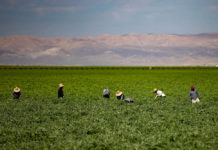It’s a lofty goal to say you are striving for 100 percent of anything. So, when on Jan. 15, 2014, the Sonoma County Winegrowers committed to making Sonoma County the nation’s first 100 percent sustainable wine region by 2019, some may have questioned setting the bar so high.
After all, with 1,800 growers and 16 AVAs (American Viticulture Areas), it’s a huge undertaking to get anything done, let alone the type of sustainable initiatives the Winegrowers set out to make.
Sonoma County’s agricultural industry has evolved over the last century. One hundred years ago, families growing grain, potatoes, hops and tending to orchards had their own “sustainability” plan — keeping their family farm going and passing it down to the next generation. That was their commitment.
In 2015, sustainability plans look much different. The plans have to be intentional and they have to be industry driven, not just family driven (though that is still the case with some multi-generational grapegrowers).
Dane and Brad Petersen are good examples of the dual role the multi-generational farmers are playing in preserving the land and farming sustainably.
Dane has passed on a legacy not only of growing grapes, but of sustainable farming practices.
“We may not have called it sustainability thirty years ago, but we did believe taking care of the land was critical to growing the best grapes. Back then we were always looking for ways to be softer on the land,” Dane said.
Brad (Dane’s son) is chairman of the Sonoma County Winegrape Commission and vineyard manager at Silver Oak Cellars and Twomey Cellars. He believes that farmers strive to produce the best crop they can while preserving the land just as the generation of farmers before them have done.
Becoming 100 percent sustainable helps demonstrate that “we are good stewards of the land, that we do care for the communities that we live and work in, and that we want to be able to pass this fine tradition on to the next generation.”
That was essentially the impetus for the Sonoma County Winegrowers 100 percent sustainability goal and last week; the group also announced a 100-year plan to preserve agriculture in Sonoma County.
Their creed says it well: “We are farmers always. We are grape growers today. We believe in preserving agriculture for future generations. We see sustainability as our compass for better farming and business. We understand that history offers a guide to making decisions in the future. We believe in continuous learning, improvement and collaboration. We are positive contributors to our community and industry. We are caretakers of the land we inherited on behalf of those who will inherit it from us.”
So, how are they doing?
Karissa Kruse, President of the Sonoma County Winegrowers, gave a detailed report on the first year of the sustainability initiative last week. She said that since January of 2014, 43 percent of the vineyard acres in Sonoma county have gone through the sustainability assessment and 33 percent of the vineyards have taken the next step and are now certified sustainable under a third-party auditor program. These were likely the “low-hanging fruit” — the growers who were already practicing sustainable farming before this initiative came along, but it’s a good first year nonetheless. (The full “1st Annual Sustainability Report” is inserted into this week’s issue.)
When you take into account that the goals aren’t just benefiting our environment, but the bottom line as well, the “march towards sustainability” looks even greater. It’s not just a public relations campaign. The wine industry contributed more than $13 billion to our local economy and accounted for one in three jobs in 2012.
While there is still plenty of work to be done, this first year’s report proves that becoming 100 percent sustainable is not only a worthwhile goal, it’s likely within reach.
— Kerrie Lindecker
49.9
F
Healdsburg
April 20, 2025







